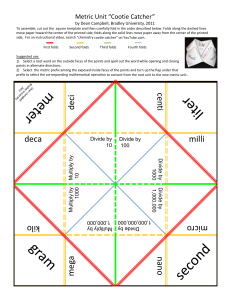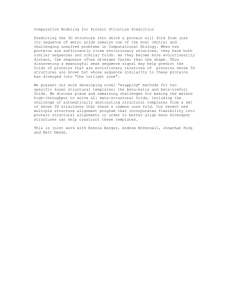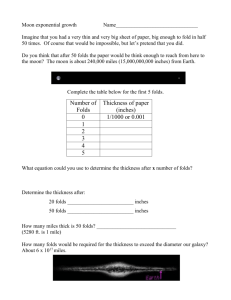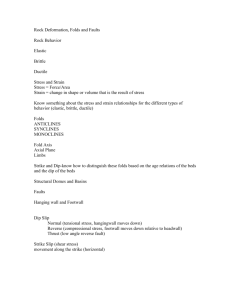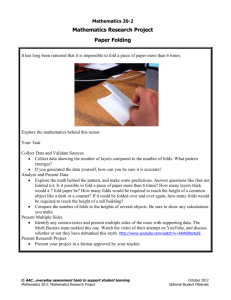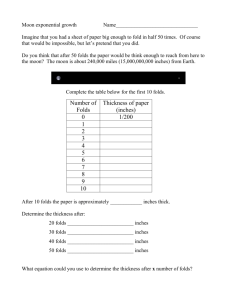NMBGMR OFR454D
advertisement
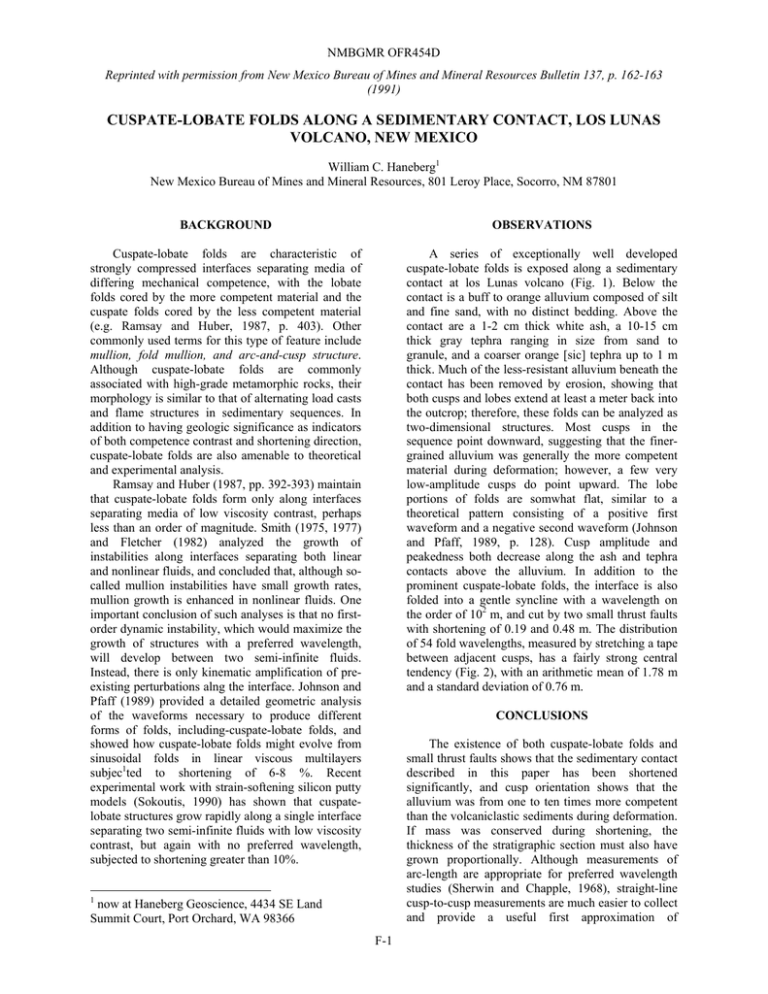
NMBGMR OFR454D Reprinted with permission from New Mexico Bureau of Mines and Mineral Resources Bulletin 137, p. 162-163 (1991) CUSPATE-LOBATE FOLDS ALONG A SEDIMENTARY CONTACT, LOS LUNAS VOLCANO, NEW MEXICO William C. Haneberg1 New Mexico Bureau of Mines and Mineral Resources, 801 Leroy Place, Socorro, NM 87801 BACKGROUND OBSERVATIONS Cuspate-lobate folds are characteristic of strongly compressed interfaces separating media of differing mechanical competence, with the lobate folds cored by the more competent material and the cuspate folds cored by the less competent material (e.g. Ramsay and Huber, 1987, p. 403). Other commonly used terms for this type of feature include mullion, fold mullion, and arc-and-cusp structure. Although cuspate-lobate folds are commonly associated with high-grade metamorphic rocks, their morphology is similar to that of alternating load casts and flame structures in sedimentary sequences. In addition to having geologic significance as indicators of both competence contrast and shortening direction, cuspate-lobate folds are also amenable to theoretical and experimental analysis. Ramsay and Huber (1987, pp. 392-393) maintain that cuspate-lobate folds form only along interfaces separating media of low viscosity contrast, perhaps less than an order of magnitude. Smith (1975, 1977) and Fletcher (1982) analyzed the growth of instabilities along interfaces separating both linear and nonlinear fluids, and concluded that, although socalled mullion instabilities have small growth rates, mullion growth is enhanced in nonlinear fluids. One important conclusion of such analyses is that no firstorder dynamic instability, which would maximize the growth of structures with a preferred wavelength, will develop between two semi-infinite fluids. Instead, there is only kinematic amplification of preexisting perturbations alng the interface. Johnson and Pfaff (1989) provided a detailed geometric analysis of the waveforms necessary to produce different forms of folds, including-cuspate-lobate folds, and showed how cuspate-lobate folds might evolve from sinusoidal folds in linear viscous multilayers subjec1ted to shortening of 6-8 %. Recent experimental work with strain-softening silicon putty models (Sokoutis, 1990) has shown that cuspatelobate structures grow rapidly along a single interface separating two semi-infinite fluids with low viscosity contrast, but again with no preferred wavelength, subjected to shortening greater than 10%. A series of exceptionally well developed cuspate-lobate folds is exposed along a sedimentary contact at los Lunas volcano (Fig. 1). Below the contact is a buff to orange alluvium composed of silt and fine sand, with no distinct bedding. Above the contact are a 1-2 cm thick white ash, a 10-15 cm thick gray tephra ranging in size from sand to granule, and a coarser orange [sic] tephra up to 1 m thick. Much of the less-resistant alluvium beneath the contact has been removed by erosion, showing that both cusps and lobes extend at least a meter back into the outcrop; therefore, these folds can be analyzed as two-dimensional structures. Most cusps in the sequence point downward, suggesting that the finergrained alluvium was generally the more competent material during deformation; however, a few very low-amplitude cusps do point upward. The lobe portions of folds are somwhat flat, similar to a theoretical pattern consisting of a positive first waveform and a negative second waveform (Johnson and Pfaff, 1989, p. 128). Cusp amplitude and peakedness both decrease along the ash and tephra contacts above the alluvium. In addition to the prominent cuspate-lobate folds, the interface is also folded into a gentle syncline with a wavelength on the order of 102 m, and cut by two small thrust faults with shortening of 0.19 and 0.48 m. The distribution of 54 fold wavelengths, measured by stretching a tape between adjacent cusps, has a fairly strong central tendency (Fig. 2), with an arithmetic mean of 1.78 m and a standard deviation of 0.76 m. CONCLUSIONS The existence of both cuspate-lobate folds and small thrust faults shows that the sedimentary contact described in this paper has been shortened significantly, and cusp orientation shows that the alluvium was from one to ten times more competent than the volcaniclastic sediments during deformation. If mass was conserved during shortening, the thickness of the stratigraphic section must also have grown proportionally. Although measurements of arc-length are appropriate for preferred wavelength studies (Sherwin and Chapple, 1968), straight-line cusp-to-cusp measurements are much easier to collect and provide a useful first approximation of 1 now at Haneberg Geoscience, 4434 SE Land Summit Court, Port Orchard, WA 98366 F-1 NMBGMR OFR454D wavelength distribution. Because neither theory nor experiment predict the existence of a preferred wavelength for cuspate-lobate folds along a single interface, we are faced with two alternative explanations for our observation of somewhat uniform wavelength. First, the cuspate-lobate folds could represent the amplification of pre-existing perturbations along the interface, for example ripple marks. Second, it is possible that a preferred wavelength evolved because the sediments on one or both sides of the interface behaved as finite layers, for which dynamic instabilities will arise. Smith (1975) for example, suggests that many cuspatelobate folds along single interfaces in the field are actually the erosional remnants of a finite layer with cuspate-lobate folds along both interfaces. At present, meager knowledge of the depositonal and deformational history of these sediments does not allow either of these explanations to be favored over the other. It is hoped, however, that detailed mapping and mechanical analysis will provide a better understanding of the exceptional structures at Los Lunas volcano. Figure 2. Histogram and sample statistics of cusp-tocusp wavelengths of 54 cuspate-lobate folds measured at Los Lunas volcano. ACKNOWLEDGMENTS This work was supported by the New Mexico Bureau of Mines & Mineral Resources. David Love introduced me to a number of structural problems along the flanks of Los Lunas volcano, assisted with wavelength measurements, and, along with John Hawley, read drafts of this contribution. REFERENCES Fletcher, R. C., 1982, Analysis of the flow in layered fluids at small, but finite, amplitudes with application to mullion structures: Tectonophysics, v. 81, pp. 51-66. Johnson, A. M., and Pfaff, V. J., 1989, Parallel, similar and constrained folds; in Johnson, A. M., Burnham, C. W., Allen, C. R., and Muehlberger, W., (eds.), Richard H. Jahns Memorial Volume: Engineering Geology, v. 27, pp. 115-180. Ramsay, J. G., and Huber, M. I., 1987, The techniques of modern structural geology, Vol. 2: Folds and fractures: Academic Press, London, 700 pp. Sherwin, J., and Chapple, W. M., 1968, Wavelengths of single layer folds: a comparison between theory and observation: Americal Journal of Science, v. 266, pp. 167-179. Smith, R. B., 1975, Unified theory of the onset of folding, boudinage, and mullion structure: Geological Society of America, Bulletin, v. 86, pp. 1601-1609. Smith, R. B., 1977, Formation of folds, boudinage, and mullions in non-Newtonian materials: Geological Society of America, Bulletin, v. 888, pp. 312-320. Sokoutis, D., 1990, Experimental mullions at single and double interfaces: Journal of Structural Geology, v. 12, pp. 365-373. Figure 1. Example of cuspate-lobate folds developed along interface between fine-grained alluvium (lower) and ash-tephra sequence (upper) at Los Lunas volcano. Note changes in cusp amplitude and peakedness along bedding surface in volcaniclastic sediments. Hammer handle is approximately 33 cm long. F-2

